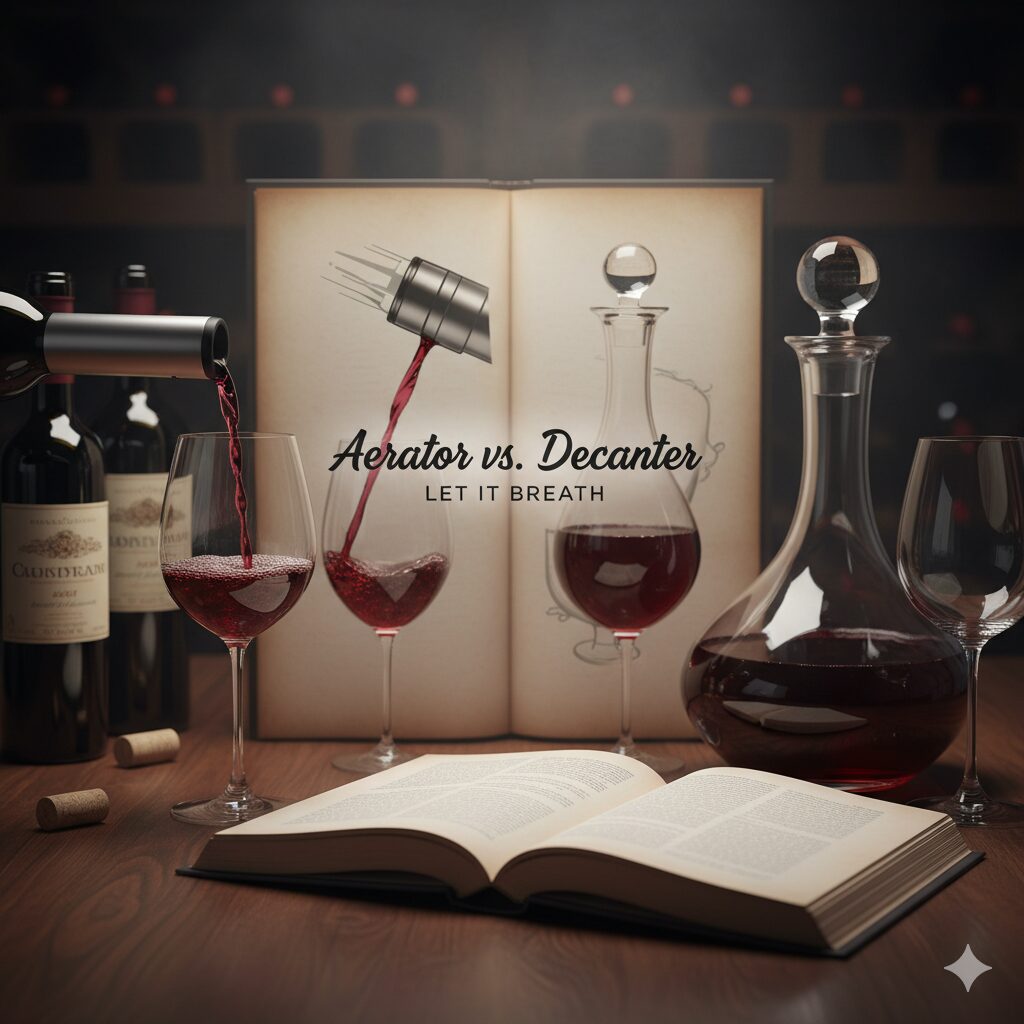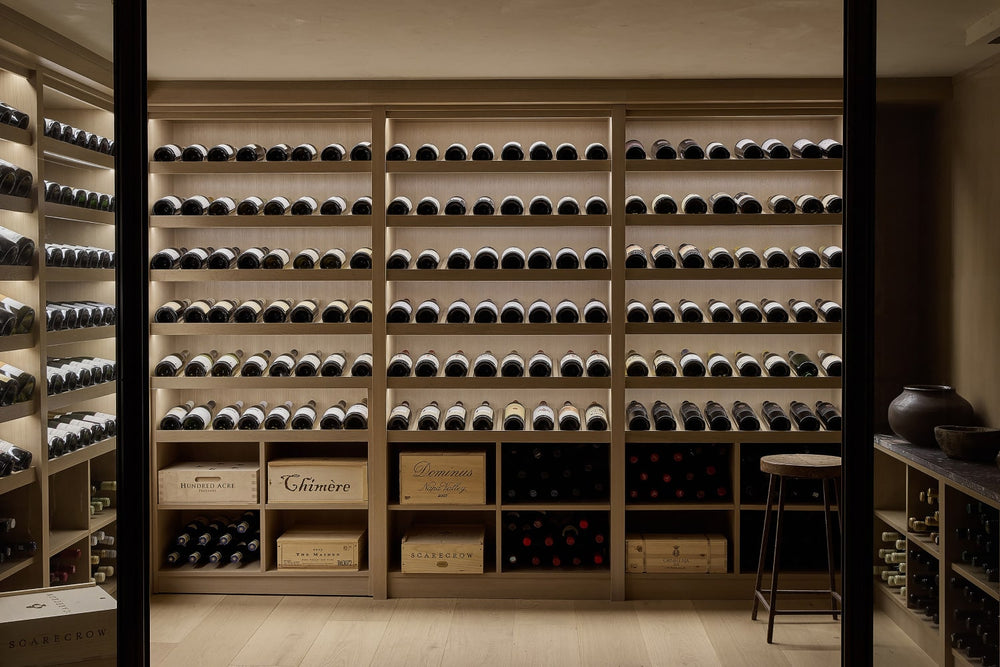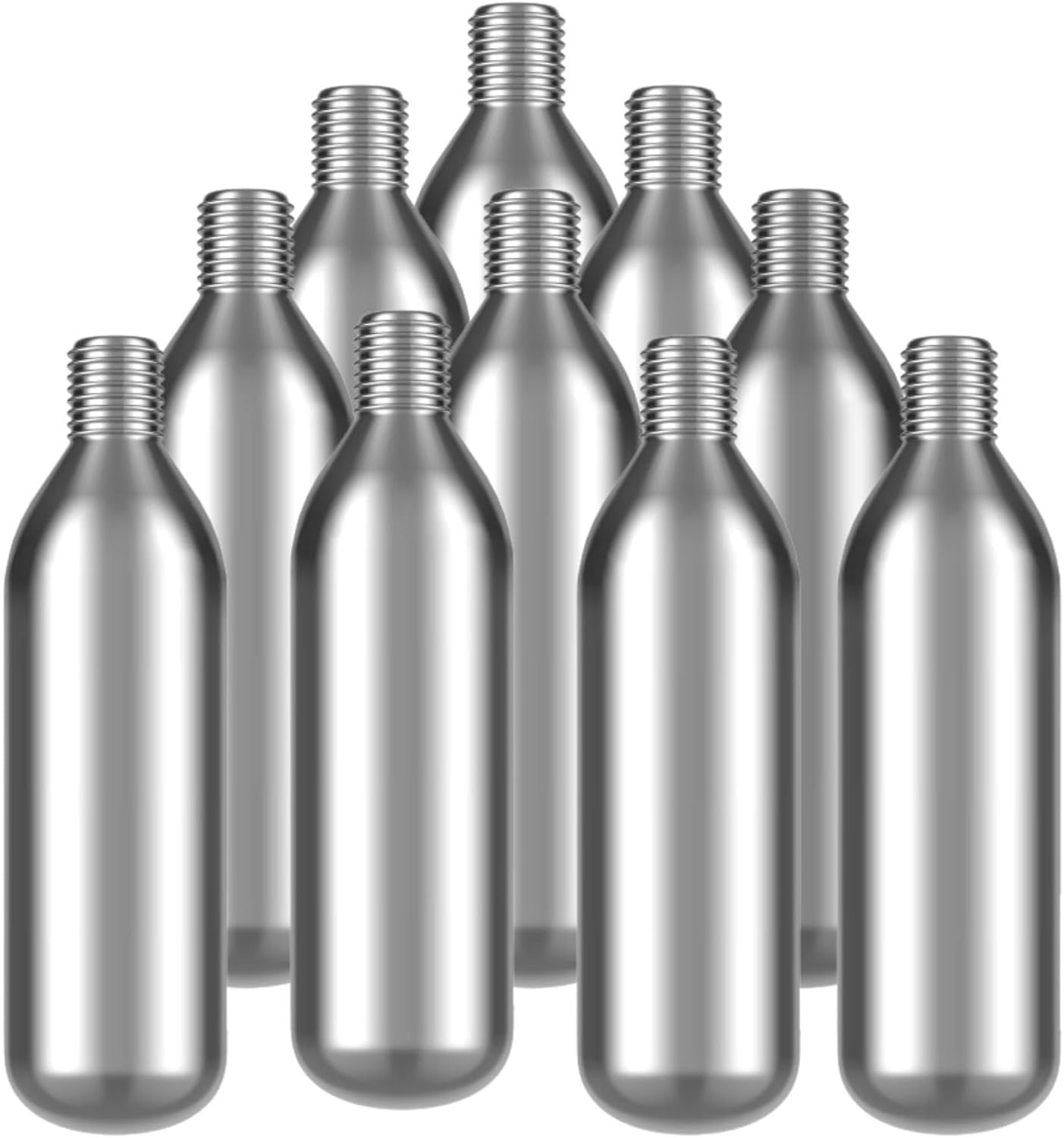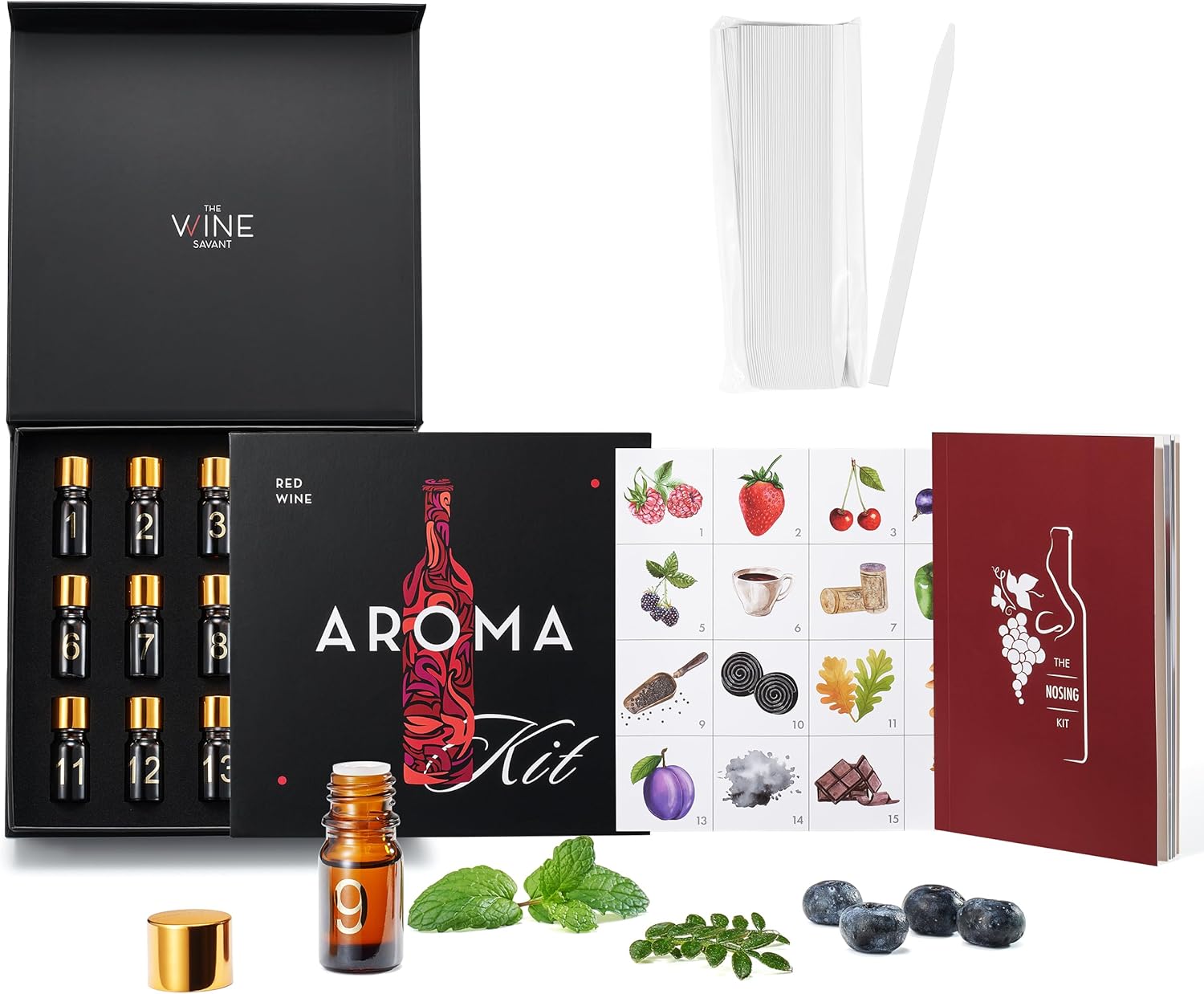Aerator vs. Decanter: The Great Debate on Letting Wine Breathe
Every wine lover has had the experience: you open a promising bottle of red wine, pour a glass, and take a sip… only to be met with a muted, tight, and disappointingly harsh wall of flavor. The wine feels “closed off,” its beautiful aromas and flavors locked away. The secret to unlocking them is simple: oxygen. For centuries, the elegant decanter has been the tool of choice for this ritual. But in our fast-paced world, the instant gratification of the wine aerator has emerged as a powerful contender. So, which is better? The timeless ceremony or the modern shortcut? It’s a battle between patience and speed, and the winner depends entirely on the wine in your bottle and the moment you’re in.

The Impatient Wine Lover’s Epiphany
I used to be a skeptic. I’d hear sommeliers talk about “letting a wine breathe” and I’d roll my eyes. My philosophy was simple: open bottle, pour wine, drink wine. This changed dramatically one night when I opened a bottle of young, powerful Barolo—a gift I’d been saving. I poured a glass right away, and it was an aggressive, tannic monster. The fruit was hidden, and the tannins felt like they were coating my tongue in sandpaper. It was practically undrinkable. Disappointed, I left the glass on the counter and forgot about it.
An hour later, I came back and took another sip out of sheer curiosity. The transformation was miraculous. The tannins had softened into a velvety texture, and a beautiful bouquet of rose, cherry, and tar had emerged. It was a completely different—and infinitely more delicious—wine. That was my lightbulb moment. I realized that oxygen wasn’t just a marketing gimmick; it was an essential ingredient. I immediately bought one of the best wine decanters I could find. My journey into aeration had begun, and it led me to explore every tool, from the classic to the cutting-edge, in pursuit of the perfect glass.
The Science of Breathing: Why Aeration Matters
To understand the difference between an aerator and a decanter, you must first understand what’s happening inside your glass. When wine is exposed to air, it triggers two key chemical processes. To get a better grasp of these, our wine terminology guide is a fantastic resource.
- Oxidation: This is a slow, controlled “aging” process. A small amount of oxygen interacts with the wine’s phenolic compounds, most notably the **tannins**. In young, bold red wines, tannins can be harsh and astringent. Oxidation softens them, smoothing out the wine’s texture and making it feel much more supple and pleasant on the palate.
- Volatilization: Wine is full of volatile compounds, which are the tiny molecules responsible for its aroma. When you first open a bottle, many of these are “trapped.” Exposing the wine to air allows these compounds to evaporate and release into the air, creating the wine’s “bouquet.” This is why a wine becomes more aromatic after it has been open for a while. Aeration dramatically speeds up this process.
A decanter and an aerator are both tools designed to accelerate these two processes. The fundamental difference lies in **Time vs. Intensity**. A decanter uses a large surface area for a slow, gentle aeration over time. An aerator uses physics to create a rapid, intense burst of aeration in seconds.
The Contenders: A Deep Dive into Decanters and Aerators
1. The Decanter (The Time-Honored Ritual)
The decanter is the classic, elegant solution to aeration. By pouring wine from the bottle into a wide-bottomed vessel, you dramatically increase the wine’s surface area that is exposed to oxygen. This allows for a slow, gentle, and controlled aeration process. A decanter serves a crucial dual purpose:
1. Aeration for Young Wines: For a young, tannic red (like a Cabernet Sauvignon, Syrah, or Nebbiolo), an hour or two in a decanter can work wonders, softening the tannins and allowing the primary fruit aromas to blossom. 2. Sediment Separation for Old Wines: For an old, fragile wine (10+ years), the primary goal of decanting is to carefully separate the clear wine from the bitter, grainy sediment that has formed at the bottom of the bottle. This process should be done gently and immediately before serving to avoid over-exposing the delicate aged wine to oxygen. Properly storing your bottles is key to managing sediment, as explained in our guide on how to store wine at home.
Who is this best for?
The patient wine lover, the host of dinner parties, and the collector of fine or aged wines. It’s an essential tool for anyone serious about wine.
- Provides gentle, controlled aeration for delicate wines
- The only proper way to separate sediment from aged wines
- Creates a beautiful centerpiece and enhances the serving ritual
- Can handle a full 750ml bottle at once
- A classic piece of essential wine cellar essentials.
Pros
- Requires time and patience (30 minutes to 2+ hours)
- Can be bulky to store and delicate to clean
- Not practical for a spontaneous single glass
Cons
2. The Wine Aerator (The Modern Shortcut)
The wine aerator is a marvel of fluid dynamics, designed for maximum aeration in minimum time. Most handheld aerators like the popular Vinturi work on the **Bernoulli principle**. As you pour wine through the aerator’s chamber, its speed increases, which causes a decrease in pressure. This pressure drop draws in air through small side channels, instantly infusing the wine with a huge amount of oxygen as it flows into your glass. Other styles attach to the bottle like a pourer, aerating the wine as it leaves the bottle.
The effect is dramatic and immediate. You can pour a glass of a young, tight red through an aerator and it will taste as if it has been decanting for 30-60 minutes. It’s the ultimate tool for instant gratification, perfect for a weeknight glass or when you spontaneously open one of the best affordable wines and want to enjoy it at its peak right away. It’s one of the best wine accessories every host needs for impromptu gatherings.
Who is this best for?
The busy wine lover, the person who often enjoys just a glass or two, or anyone who wants to improve their everyday wines without the wait.
- Provides instant aeration in the time it takes to pour a glass
- Small, portable, and easy to clean and store
- Perfect for aerating wine by the glass
- Significantly improves the taste of young, inexpensive red wines
Pros
- Too aggressive for delicate or aged wines
- Cannot separate sediment
- Lacks the ceremony and elegance of a decanter
Cons
Head-to-Head: The Great Aeration Experiment
To see the difference in real-time, I conducted a simple but revealing experiment. I chose a bottle of a young (2023), notoriously tannic California Cabernet Sauvignon. I divided the bottle into three test groups, serving each in one of the best wine glasses for red wine to ensure consistency.
- Glass A (Control): Poured directly from the bottle and tasted immediately.
- Glass B (Aerator): Poured through a Vinturi-style aerator and tasted immediately.
- Glass C (Decanter): The rest of the bottle was poured into a decanter. After one hour, a glass was poured and tasted.
The Sensory Results
- Glass A (Control): The aroma was muted, mostly just alcohol and a hint of dark fruit. On the palate, it was aggressive. The tannins were grippy and overpowering, drying out the finish and masking the fruit. It was a classic case of a wine needing time.
- Glass B (Aerator): A huge difference. The aroma immediately exploded from the glass—ripe blackberry, cassis, and a hint of vanilla. On the palate, the wine was noticeably smoother. The tannins were still present, but they were much softer and better integrated. It tasted like a much more expensive and well-structured wine. The speed of the transformation was incredible.
- Glass C (Decanter): The pinnacle of the experience. The aroma was even more complex and nuanced than the aerated glass, with subtle notes of cedar and spice emerging. The palate was the smoothest of all three, with the tannins resolved into a plush, velvety texture. The wine felt completely in balance, with a long, elegant finish. It was clearly the “best” version of the wine, but it required an hour of patience.
| Feature | Wine Aerator | Wine Decanter |
|---|---|---|
| Primary Function | Intense, rapid aeration | Gentle aeration & sediment separation |
| Time Required | Seconds | 30 minutes to 2+ hours |
| Best For… | Young, bold red wines; everyday drinking | Young bold reds, AND old fragile reds |
| Ideal Use Case | A spontaneous glass, weeknight wines, parties | Dinner parties, tasting fine wines, cellared bottles |
| Sediment Removal? | ✗ | ✓ |
| Portability/Storage | Excellent (small, easy to store) | Poor (bulky, often fragile) |
| Cleaning | Very easy (rinse under tap) | Can be difficult and requires special brushes |
The Final Verdict: Which Should You Own?
After extensive testing and countless glasses of wine, the answer is clear. The debate between aerator and decanter is not about which one is “better,” but which one is “better for the moment.” They are not mutually exclusive; they are complementary tools in a wine lover’s arsenal.
You Should Buy a Decanter If…
- You enjoy the ritual and ceremony of serving wine.
- You host dinner parties where a full bottle will be consumed.
- You collect or drink aged wines that may have sediment.
- You have the patience to let a great wine evolve to its peak.
- You’re looking for an elegant wine gift idea.
You Should Buy an Aerator If…
- You want to improve a glass of wine on a weeknight, instantly.
- You often only drink one or two glasses from a bottle.
- You primarily drink young, bold, affordable red wines.
- You value convenience, speed, and easy storage.
- You need a portable tool to take to parties or restaurants.
My expert recommendation? **Own both.** I consider them both to be essential. I use my aerator 3-4 times a week for those spontaneous glasses of Malbec or Cabernet. It lives in my utensil drawer, always ready. My beautiful decanter comes out on weekends, when I’m opening a special bottle to share with friends, or when I’m delving into my small collection of aged wines that I store carefully. The aerator is my everyday workhorse; the decanter is my special occasion artist.
By understanding what each tool does best, you can stop drinking wine that’s merely “open” and start enjoying wine that is truly alive and expressive, no matter the day of the week.
What does aerating wine actually do?
Aerating wine introduces oxygen, which accomplishes two main things. First, it softens tannins—the compounds in red wine that can feel harsh or drying—through a process of limited oxidation, making the wine feel smoother. Second, it encourages evaporation of volatile aromatic compounds, allowing the wine’s bouquet to “open up” and become much more expressive and fragrant. To learn about more wine terms, check out our beginner’s wine glossary.
Can you over-aerate a wine?
Yes, and it’s a critical point. While young, robust red wines are resilient, older and more delicate wines (like an aged Burgundy or a light-bodied Pinot Noir) have very fragile aromas. Too much oxygen exposure, especially from an aggressive aerator, can cause these delicate notes to blow off and disappear, leaving the wine tasting flat. For old wines, the rule is to decant gently and only for sediment, serving immediately.
How long should I decant a red wine?
It varies greatly by the wine varietal and its age. As a general rule of thumb for young, tannic red wines:
- Full-bodied reds (Cabernet, Syrah, Barolo): 1-2 hours.
- Medium-bodied reds (Merlot, Malbec): 30-60 minutes.
- Light-bodied reds (Pinot Noir, Gamay): 20-30 minutes, if at all.
Does just opening the bottle and letting it sit work?
No, this is a common myth. The tiny surface area of wine exposed to air in the neck of a bottle is insufficient to provide any meaningful aeration. You could leave a bottle open for hours and see very little change. To properly aerate wine, you must increase the surface area, which is exactly what a decanter or an aerator is designed to do.


























